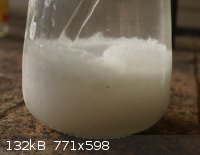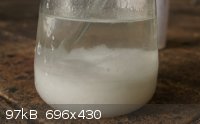Chemistry Alchemist
Hazard to Others
  
Posts: 403
Registered: 2-8-2011
Location: Australia
Member Is Offline
Mood: No Mood
|
|
Portassium nitrate synthesis problem
I've been looking for some potassium hydroxide every where, and happened to find pH up that contains potassium hydroxide, now I added 56 grams of it
too 80 grams of ammonium nitrate, both in different solutions... When I added one to another it looked like no reaction occurred (it's ment to fix
with the release of ammonia gas), this didn't occur, but after a quick mix of the solution it turned a milky color as a white precipitate forms while
small amounts of ammonia is formed... What is this white precipitate? Is it potassium nitrate?
The precipiate is kinda fluffy with needle like crystal structure... Do u know what's happening?
[Edited on 8-11-2011 by Chemistry Alchemist]
|
|
|
woelen
Super Administrator
        
Posts: 7977
Registered: 20-8-2005
Location: Netherlands
Member Is Offline
Mood: interested
|
|
Were your solutions strongly concentrated? If that is the case, then the needle-like crystals most likely are KNO3. KNO3 forms needle-like crystals, I
have made them many times myself. These crystals can become large, with a length of several cm.
How large are your crystals?
|
|
|
Chemistry Alchemist
Hazard to Others
  
Posts: 403
Registered: 2-8-2011
Location: Australia
Member Is Offline
Mood: No Mood
|
|
The potassium hydroxide was a bit dilute I think... It came in a 250ml bottle, and too equal the mass that I'm supposed to be I need 140mls of it to
form the 56 grams of KOH... So it was a bit dilute but for the ammonium nitrate I dissolved all 80 grams in 100 mls of water and then mixed the,
both... Ending up with about 240 mls of solution... Most of the precipitate is just a powder but I got a few needle like structures forming about
0.5cm long...
|
|
|
woelen
Super Administrator
        
Posts: 7977
Registered: 20-8-2005
Location: Netherlands
Member Is Offline
Mood: interested
|
|
While the precipitate is in the liquid, boil it until all of the white precipitate has dissolved and then keep boiling, until solid is formed in the
water, or until a crust is formed on the surface of the water. Then set aside and let cool down slowly. During the boiling ammonia vapor may be
released. Do the boiling outside or in a very well ventilated room.
If the precipitate does not dissolve on boiling, then it is no KNO3. When all dissolves and you get new crystals of KNO3 on cooling, then these will
be much purer. If the liquid has cooled down to room temperature, you can put it in the fridge to let it cool down further. In this way you will
recover certainly 90% of all KNO3.
|
|
|
Chemistry Alchemist
Hazard to Others
  
Posts: 403
Registered: 2-8-2011
Location: Australia
Member Is Offline
Mood: No Mood
|
|
So what would the white precipitate be that i have?
|
|
|
Chemistry Alchemist
Hazard to Others
  
Posts: 403
Registered: 2-8-2011
Location: Australia
Member Is Offline
Mood: No Mood
|
|
I have some pictures of the precipitate below


|
|
|
Retard-3000
Hazard to Self
 
Posts: 55
Registered: 17-11-2010
Member Is Offline
Mood: No Mood
|
|
For the best yields you'll want to dissolve the potassium hydroxide in as little water as possible and do the same for the ammonium nitrate otherwise
any excess water will immediately dissolve any ammonia formed.
|
|
|
Neil
National Hazard
   
Posts: 556
Registered: 19-3-2008
Member Is Offline
Mood: No Mood
|
|
Woelen gave you a way to find out if it is KNO3. Do what he suggested and see if it dissolves and then recrystallize it. The more it looks like
superman's castle of solitude, the better the purity

|
|
|
Chemistry Alchemist
Hazard to Others
  
Posts: 403
Registered: 2-8-2011
Location: Australia
Member Is Offline
Mood: No Mood
|
|
I boiled the precipitate with the solution, the precipitate fully disolved once it started to warm up and the ammonium hydroxide started to decompose,
after the solution evaporate enough i made it so its satuated with KNO3, took it off heat and out it int he freezer too cool, after about 30 min i
took it out and 90% of it had precipitated out so i wash the precipitate with cold water and in the process of drying... i tested it some with sugar
and burned nicely  ill put a thanks into the end of my video when i make it too
all that helps ill put a thanks into the end of my video when i make it too
all that helps 
|
|
|
woelen
Super Administrator
        
Posts: 7977
Registered: 20-8-2005
Location: Netherlands
Member Is Offline
Mood: interested
|
|
Good to read that you succeeded in this!
KNO3 has the very nice property that its solubility strongly increases with temperature and that makes the salt very easy to separate from its
solutions.
|
|
|
Chemistry Alchemist
Hazard to Others
  
Posts: 403
Registered: 2-8-2011
Location: Australia
Member Is Offline
Mood: No Mood
|
|
I put up the video tonight  if you want to see it, the link is below if you want to see it, the link is below  thanks ScienceMadness for the help thanks ScienceMadness for the help 
http://www.youtube.com/watch?v=LboODKcB6Jw
|
|
|
woelen
Super Administrator
        
Posts: 7977
Registered: 20-8-2005
Location: Netherlands
Member Is Offline
Mood: interested
|
|
Nice video, but I have some comments on the text, associated with it. You are talking about ammonium hydroxide. That is not correct. In solution you
simply have ammonia, and that is how it is called correctly.
Also, do not mention that a vigorous reaction should occur. In this solution, the ammonia simply is too much diluted and the vigorous reaction does
not occur. I never would expect a vigorous reaction when mixing a concentrated ammonium salt solution with a concentrated hydroxide solution. Only if
solids are mixed and a drop of water is added, you will get foaming and production of gaseous ammonia.
|
|
|
Chemistry Alchemist
Hazard to Others
  
Posts: 403
Registered: 2-8-2011
Location: Australia
Member Is Offline
Mood: No Mood
|
|
But ammonium hydroxide is just simply ammonia dissolved in water... thats correct isnt it?
Vigorous reaction - i said that because in NurdRages video when he added the 2, it reacted with alot of bubbling... sorry for my mistakes
|
|
|
woelen
Super Administrator
        
Posts: 7977
Registered: 20-8-2005
Location: Netherlands
Member Is Offline
Mood: interested
|
|
A solution of ammonia in water only dissociates into ammonium ions and hydroxide ions for a very small part. Only 0.1% or so of the ammonia
dissociates, most is present as NH3. Ammonia is a very weak base. For this reason, it formally is incorrect to talk about ammonium hydroxide. I see
this wrong name especially in the USA. Where I live it is not common at all, here we talk about ammonia solution.
|
|
|
Chemistry Alchemist
Hazard to Others
  
Posts: 403
Registered: 2-8-2011
Location: Australia
Member Is Offline
Mood: No Mood
|
|
Sorry about my incorrectness then... ill remember that for next time woelen 
|
|
|